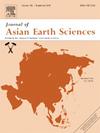印度尼西亚西苏门答腊Ombilin盆地Sangkarewang组和Sawahlunto组沉积格架
IF 2.7
3区 地球科学
Q2 GEOSCIENCES, MULTIDISCIPLINARY
引用次数: 0
摘要
最近在印度尼西亚苏门答腊岛中西部的Ombilin盆地野外采集的岩石样本进行了分析,获得了花粉数据,这些数据限制了Sangkarewang和Sawahlunto地层中相关植物大化石和脊椎动物化石单元的年龄和沉积环境。在Sangkarewang组的易裂层状页岩的层理平面上发现了铰接的鱼类和植物化石,这些页岩被解释为沉积在一个活跃沉降的深缺氧湖泊中。上覆的Sawahlunto组Talawi段的地层记录与沉积相一致,沉积在边缘湖泊沼泽和排水不良的古土壤环境中。塔拉维基段的互层碳酸盐泥岩/碎屑岩和木质素粘土岩单元保存了零散的、不连接的鱼类、爬行动物、两栖动物和哺乳动物牙齿化石。这些层被划分为细粒碎屑岩的异质时代序列,煤互层可能沉积在沿海冲积环境中。这段时间的海洋影响体现在几个带的物理沉积构造的性质、diplocrateria、ichnus和Teichichnus等化石的存在,以及有孔虫衬里、藻囊和其他指示红树林和红树林后环境的形态。孢粉学分析表明,Sawahlunto组最可能的年代为中始新世至晚始新世,可能延伸至中始新世至早渐新世。本文章由计算机程序翻译,如有差异,请以英文原文为准。

Depositional framework of the Sangkarewang and Sawahlunto Formations, Ombilin Basin, West Sumatra, Indonesia
Analyses of rock samples collected during recent fieldwork in the Ombilin Basin of west-central Sumatra, Indonesia yielded pollen data that constrain the age and depositional setting of associated plant macrofossil and vertebrate fossil-bearing units in the Sangkarewang and Sawahlunto formations. Articulated fish and plant fossils were recovered from bedding plane surfaces of fissile, laminated shales in the Sangkarewang Formation that are interpreted to have been deposited in an actively-subsiding, deep, anoxic lake. The overlying Talawi Member of the Sawahlunto Formation records stratigraphy consistent with deposition in a segue to marginal lacustrine marsh and poorly-drained paleosol settings. Interbedded carbonate mudstone / wackestone and lignitic claystone units in the basal Talawi Member preserve scattered, disarticulated fossils of fish, reptiles, an amphibian, and one mammal tooth. These beds grade into a heterolithic succession of fine-grained clastic rock, with coal interbeds likely deposited in a coastal alluvial setting. Marine influences in this interval are indicated by the nature of physical sedimentary structures in several zones, the presence of trace fossils such as Diplocraterion, Cylindrichnus and Teichichnus, and the occurrence of foraminiferal linings, dinocysts and other palynomorphs indicative of mangrove and back-mangrove settings. Palynological analysis indicates that the most probable age of the Sawahlunto Formation ranges from the middle to late Eocene, with a possible extension from the middle Eocene to the early Oligocene.
求助全文
通过发布文献求助,成功后即可免费获取论文全文。
去求助
来源期刊

Journal of Asian Earth Sciences
地学-地球科学综合
CiteScore
5.90
自引率
10.00%
发文量
324
审稿时长
71 days
期刊介绍:
Journal of Asian Earth Sciences has an open access mirror journal Journal of Asian Earth Sciences: X, sharing the same aims and scope, editorial team, submission system and rigorous peer review.
The Journal of Asian Earth Sciences is an international interdisciplinary journal devoted to all aspects of research related to the solid Earth Sciences of Asia. The Journal publishes high quality, peer-reviewed scientific papers on the regional geology, tectonics, geochemistry and geophysics of Asia. It will be devoted primarily to research papers but short communications relating to new developments of broad interest, reviews and book reviews will also be included. Papers must have international appeal and should present work of more than local significance.
The scope includes deep processes of the Asian continent and its adjacent oceans; seismology and earthquakes; orogeny, magmatism, metamorphism and volcanism; growth, deformation and destruction of the Asian crust; crust-mantle interaction; evolution of life (early life, biostratigraphy, biogeography and mass-extinction); fluids, fluxes and reservoirs of mineral and energy resources; surface processes (weathering, erosion, transport and deposition of sediments) and resulting geomorphology; and the response of the Earth to global climate change as viewed within the Asian continent and surrounding oceans.
 求助内容:
求助内容: 应助结果提醒方式:
应助结果提醒方式:


